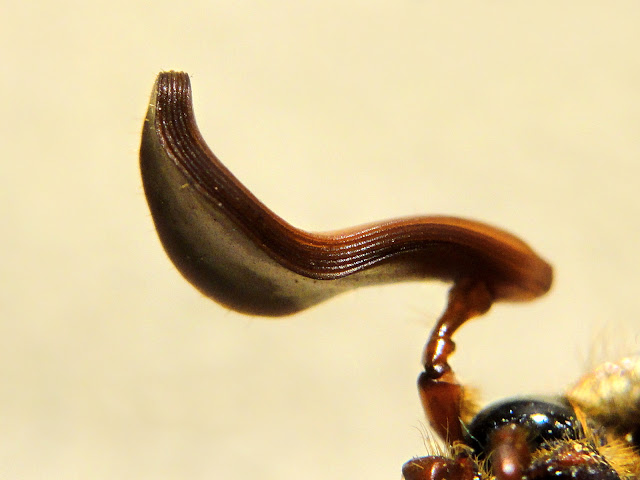At the clearing near Nimpkish Lake, the soil is shallow, mostly made up of dust from the cliffs above and gravel from road-building activity. This far north, the growing season is short and dry, the winters long, dark, and sopping wet. It's good country for evergreen trees; not so nurturing for smaller, short-lived plants. The tallest plants in the clearing were the grasses near the edge, mostly less than a foot tall.
Towards the centre, away from the shelter of cliffs and trees, most of the vegetation hugs the ground, staying out of the wind, close to any dampness available. I got down on my knees and elbows to look at the lichen and found much more.
 |
| Cladonia lichen*, moss sporophytes, Alpine azalea**, and a miniature flower with interesting leaves***. |
If you look closely, you can (barely) see the moss; dark, yellowish-brown clusters. I think the green shrub is the Alpine azalea,
Loisleleuria procumbens, which has leaves from 3 to 8 mm long (about 1/8 to just over 1/4 inch). I can't identify the tiny plant on the far left; I didn't even see it while I was there, so didn't aim the camera at it.
Update #2: In the comments, Matt Goff, of
Sitka Nature, identified the lichen (*) as a
Stereocaulon. I found one of these growing in this area, on E-Flora; the
Stereocaulon alpinum, Alpine foam. (I like the name.)
** Matt says he doesn't think the green shrub is Alpine azalea, but has no suggestions.
*** And the tiniest flower, up in the top left corner is an
Euphrasia, aka eyebright. E-Flora has two on Vancouver Island;
E. nemorosa, common eyebright; one of those records is of a find beside the road near Port Hardy, a bit north of where I found this one. And the Arctic eyebright,
E. subarctica, was found also beside the road; at Keta Lake, a bit to the south.
 |
| Moss sporophytes, standing tall (ish) on brown stalks, encased in pointed wrappings. A few have shed the covering. |
 |
| On the right, the lichen has dark brown spots, reproductive structures. And on the left, an intriguing spotted, hairy plant. If the azalea leaves are 1/4 inch long, the leaves of the spotted plant would be about 1/2 inch. |
I couldn't identify this plant. I think it may be the same as the one I found near Heckman Pass (on the Bella Coola road)
a couple of years ago.
 |
| Not quite so spotty, but otherwise similar. Somewhat larger. |
I couldn't identify it then, either. Any ideas?
Update: It's one of the hawkweeds, either Mouse-ear hawkweed,
Hieracium pilosella, or White-flowered hawkweed,
Hieracium albiflorum. Here are the white-flowered ones just across the water in Powell River, on
Powell River Books Blog.
Update # 3: It's been definitely identified as the White-flowered hawkweed.
 |
| Nimkish Lake area and Heckman Pass, more or less. |



















































